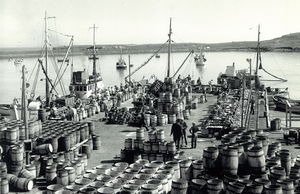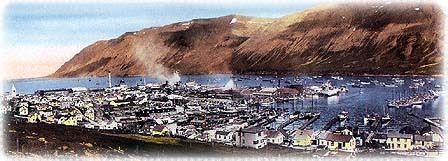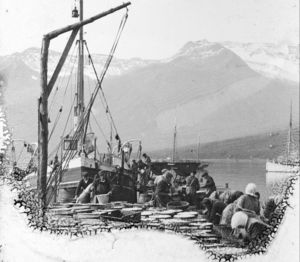History in short
Iceland's Herring Adventure (1867-1968)
Herring is one of this century's principal shapers of Icelanders' destinies. Without herring it is questionable whether the modern society that now exists in Iceland could ever have developed.
- Icelandic Historical Atlas, Vol.3, p.40
Icelandic fishermen and vessel owners were introduced to new fisheries technology around the turn of the century. The arrival of machine powered ships and highly efficient gear made extensive cod and herring fisheries possible. Rapid social improvements also helped usher in a new era, and widespread poverty and stagnation gradually became a thing of the past.
Good herring seasons during the great depression of the 1930s, a period when overseas cod markets were closed, probably ensured Iceland economic independence and played a role in enabling the country to achieve freedom in 1944, following five centuries of Danish domination.
The events surrounding the herring fisheries were like an adventure for the Icelandic nation - the great herring adventure that lasted a full one hundred years.
The Norwegian Influence
It all began in the latter half of the 19th century with the arrival of Norwegians. They utilized immense land based nets in the fjords of eastern Iceland and Eyjafjörður in the north of the country. There, Norwegian vessel owners were prominent, and were soon buying sites and properties along the coasts, building houses and piers, and exerting great influence on the economic and urban development of places such as Seyðisfjörður and Eskifjörður in the Eastern Fjords.
After 1883, a combination of pack ice, cold winters and hard times put an end to Iceland's infant herring fisheries.
By 1903, the Norwegians had returned to new herring ventures in Icelandic waters. Their large fleet must have been an arresting sight as it worked the open waters off north Iceland with drift nets. Around this same time, these pioneers began experimenting with purse seine nets, with excellent results.
New herring towns were created and hundreds of Icelanders found employment processing herring for the Norwegians.
The Icelanders did not stand idly by, but participated fully in this new adventure, and soon started taking the fishing and sales activities into their own hands. Consequently the once impregnable Norwegian domination of the industry went into gradual but terminal decline. In 1916, for the first time, the barrels processed by Icelanders surpassed in number those processed by Norwegians.

Extensive Markets
Salted herring was to become a vital foodstuff for many European countries, particularly during the hungry days of the two World Wars. Crucial export markets were Sweden, Denmark, Finland, Russia, Germany and the United States.
When not salted for human consumption, herring were dispatched to reduction factories where their oil and meal were extracted. The meal subsequently became a staple pet food across Europe, while the oil had a range of uses in the chemical industry, including the manufacture of soap!
So crucial an asset was the herring catch that, for many years, it accounted for a staggering 25% of Iceland's total export earnings, with the figure occasionally reaching as high as 45%.
Iceland's first herring processing plant was built in Siglufjörður in 1911, soon to be followed by bigger and better equipped facilities at all the country's principal herring ports. The spread and scope of these factories was such that they are now recognized as marking the arrival of the first large scale industry to Iceland.
"Herring Comes and Herring Goes"
Marine resources are notoriously unstable, and herring is no exception. Following depressed catch figures in the years around 1950, herring stocks began to be fished as never before. This was due to a new and more efficient fishing technology developed in Iceland. Other countries were quick in claiming these advances for themselves.
It was during these years that more and more herring began to be caught in waters east of Iceland. In 1965 catches from east Iceland even eclipsed those from the usually productive waters north of Iceland due to the detrimental effects of cold seas.
Almost overnight the old herring towns and villages of east Iceland flourished to become the new powers in this now giant industry, but this new age of herring prosperity was short-lived.
In 1969 the herring failed to appear. The responsibility for over exploiting the once great Norwegian-Icelandic herring stock clearly lies with the largest herring fishing nations of the time: Norway, Iceland and Russia.
Iceland's herring towns, indeed the country's entire employment and economic sectors, suffered a severe blow with the disappearance of the herring. During the late 1960s, herring accounted for up to half of Iceland's export income, and was crucial in powering the country's dizzying economic growth.
The great herring adventure was over.
Herring towns
The places where herring made their mark include Bolungarvík, Ingólfsfjörður, Djúpavík, Skagaströnd, Dalvík, Hjalteyri, Dagverðareyri, Krossanes, Akureyri, Húsavík, Raufarhöfn, Þórshöfn, Vopnafjörður, Seyðisfjörður, Neskaupstaður, Eskifjörður and Reyðarfjörður.
Nowhere did herring have such an impact as on the town of Siglufjörður.

"Sigló"
The present day inhabitants of Siglufjörður still talk of the two Norwegian 'occupations' of the area: the first undertaken by the Viking Thormódur Rammi around 900 AD, the second being the 1903 herring influx that built the world's most famous herring town.
Nowhere was the influence of the herring adventure felt more strongly than in Siglufjörður. Within forty years, this once sparsely populated hamlet transformed into a thriving town of more than three thousand inhabitants. For years, the entire life of Siglufjörður centred around the herring catch and processing - the town's twenty-three salting stations and five reducing factories were a living reminder of that.
Siglufjörður was also one of the most important ports in Iceland and, on more than one occasion, herring exported from this town accounted for over 20% of the nation's total exports.
As the herring adventure progressed, a goldrush-like atmosphere settled over the town, leading to Siglufjörður been dubbed the "Atlantic Klondike". The town also became a magnet for herring speculators who came and went - some making considerable money during their stay. With its booming industry, Siglufjörður became a mecca for tens of thousands of workers and laborers seeking employment.
When bad weather and storms broke, the sheltered waters of the fjord became home to a massed fleet of hundreds of herring ships. Life on land was just as colourful: the streets of Siglufjörður were so jammed with crowds and activities that they resembled the teeming avenues of major cities.

Siglufjörður Today
Siglufjörður is the northernmost town in Iceland, and signs of its past glory as the herring capital of Iceland can still be seen. Although most of the old houses and piers of the herring era have disappeared, some prominent reminders remain. To name a few: Róaldsbrakki, The Norwegian Sailors Home (now a music school), and SR-Mjöl's factory building, Iceland's largest fish-meal extracting factory, built in 1946. It is also obvious in looking at the main street in town in particular, that some effort was made to turn Siglufjörður into a small-scale metropolis.
The town has about 1300 inhabitants, and all basic industries and services (e.g. for tourists) can be found in the town.

